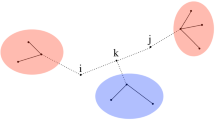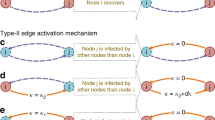Abstract
This paper focuses on the analysis of two particular models, from deterministic and random perspective respectively, for spreading processes. With a proper encoding of propagation patterns, the spread rate of each pattern is discussed for both models by virtue of the substitution dynamical systems and branching process. In view of this, we are empowered to draw a comparison between two spreading processes according to their spreading models, based on which explanations are proposed on a higher frequency of a pattern in one model than the other. These results are then supported by the numerical evidence later in the article.












Similar content being viewed by others
Data availability
All data generated or analysed during this study are included in this published article.
Notes
We will call \({\mathcal {A}}\) the \(type set \) in Sect. 2.
References
Al-Jararha M, Ou CH (2013) Population dynamics with age-dependent diffusion and death rates. Eur J Appl Math 24(4):471–500
Alexander ME, Bowman C, Moghadas SM et al (2004) A vaccination model for transmission dynamics of influenza. SIAM J Appl Dyn Syst 3(4):503–524
Athreya KB, Ney PE (2004) Branching processes. Courier Corporation, Chelmsford
Ban JC, Chang CH, Hong JI et al (2021) Mathematical analysis of spread models: from the viewpoints of deterministic and random cases. Chaos Solitons Fractals 150(111):106
Berger T, Ye ZX (1990) Entropic aspects of random fields on trees. IEEE Trans Inf Theory 36(5):1006–1018
Billings L, Bollt EM, Schwartz IB (2002) Phase-space transport of stochastic chaos in population dynamics of virus spread. Phys Rev Lett 88(23):234,101
Gourley SA, Lou YJ (2014) A mathematical model for the spatial spread and biocontrol of the Asian longhorned beetle. SIAM J Appl Math 74(3):864–884
Halle KS, Wu CW, Itoh M et al (1993) Spread spectrum communication through modulation of chaos. Int J Bifurc Chaos 3(02):469–477
** Y, Zhao XQ (2009) Spatial dynamics of a periodic population model with dispersal. Nonlinearity 22(5):1167
Lind D, Marcus B (1995) An introduction to symbolic dynamics and coding. Cambridge University Press, Cambridge
Merkin JH, Needham DJ, Sleeman BD (2005) A mathematical model for the spread of morphogens with density dependent chemosensitivity. Nonlinearity 18(6):2745
Ou CH, Wu JH (2006) Spatial spread of rabies revisited: influence of age-dependent diffusion on nonlinear dynamics. SIAM J Appl Math 67(1):138–163
Queffélec M (2010) Substitution dynamical systems-spectral analysis. Lecture notes in mathematics, vol 1294. Springer, Berlin
Ruan SG, Wu JH (2009) Modeling spatial spread of communicable diseases involving animal hosts. In: Spatial ecology, pp 293–316
Wang WD, Zhao XQ (2012) Basic reproduction numbers for reaction–diffusion epidemic models. SIAM J Appl Dyn Syst 11(4):1652–1673
Yang WG, Liu W (2002) Strong law of large numbers and Shannon–McMillan theorem for Markov chain fields on trees. IEEE Trans Inf Theory 48(1):313–318. https://doi.org/10.1109/18.971762
Yang WG, Ye ZX (2007) The asymptotic equipartition property for nonhomogeneous Markov chains indexed by a homogeneous tree. IEEE Trans Inf Theory 53(9):3275–3280
Ye ZX, Berger T (1996) Ergodic, regularity and asymptotic equipartition property of random fields on trees. J Combin Inf Syst Sci 21:157–184
Zheng H, Bonasera A (2020) Chaos, percolation and the coronavirus spread: a two-step model. Eur Phys J Plus 135(10):1–24
Acknowledgements
The authors sincerely thank the anonymous reviewers for the valuable comments which helped improve and clarify the manuscript.
Author information
Authors and Affiliations
Corresponding author
Additional information
Publisher's Note
Springer Nature remains neutral with regard to jurisdictional claims in published maps and institutional affiliations.
This work was supported by the Ministry of Science and Technology, ROC [Grant numbers MOST 109-2115-M-004-002-MY2, MOST 109-2115-M-004 -001 -MY2].
Rights and permissions
Springer Nature or its licensor (e.g. a society or other partner) holds exclusive rights to this article under a publishing agreement with the author(s) or other rightsholder(s); author self-archiving of the accepted manuscript version of this article is solely governed by the terms of such publishing agreement and applicable law.
About this article
Cite this article
Ban, JC., Hong, JI. & Wu, YL. Mathematical analysis of topological and random m-order spread models. J. Math. Biol. 86, 40 (2023). https://doi.org/10.1007/s00285-023-01874-z
Received:
Revised:
Accepted:
Published:
DOI: https://doi.org/10.1007/s00285-023-01874-z




